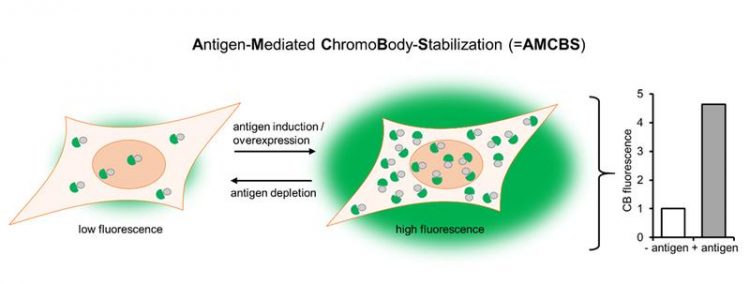Brought to light – chromobodies reveal changes in endogenous protein concentration in living cells

Antigen-Mediated-ChromoBody-Stabilization (AMCBS) NMI
In a study now published in Molecular & Cellular Proteomics, Keller et al. describe how fluorescently labeled intrabodies (so-called chromobodies) are stabilized in the presence of their target proteins.
Based on this newly uncovered property of chromobodies, the authors present a broadly applicable strategy to optimize chromobodies in order to visualize and measure changes of endogenous target proteins within living cells.
Currently available procedures to measure cellular protein concentration such as quantitative immunoblotting or mass spectrometry analysis are very laborious and time consuming.
Moreover, these approaches require destructive sample preparation and thus only deliver results at a single point in time.
“Our new approach using antigen-mediated chromobody stabilization (AMCBS) allows us to continuously visualize and quantify dynamic changes of specific endogenous proteins directly within living cells – something that could not be done before”, stated Bettina-Maria Keller, the study´s first author.
“We expect this approach to enable unprecedented insights into the dynamic regulation of proteins, e.g. during cellular signaling, cell differentiation, or upon drug action”.
Publication:
Chromobodies to quantify changes of endogenous protein concentration in living cells
Molecular & Cellular Proteomics September 18, 2018, mcp.TIR118.000914; https://doi.org/10.1074/mcp.TIR118.000914
Prof. Dr. Ulrich Rothbauer
NMI /Universität Tübingen
Markwiesenstrasse 55
72770 Reutlingen
Email: ulrich.rothbauer@nmi.de
ulrich.rothbauer@uni-tuebingen.de
Tel.: +49 (0)7121 30 415
Chromobodies to quantify changes of endogenous protein concentration in living cells
Molecular & Cellular Proteomics September 18, 2018, mcp.TIR118.000914; https://doi.org/10.1074/mcp.TIR118.000914
Media Contact
All latest news from the category: Life Sciences and Chemistry
Articles and reports from the Life Sciences and chemistry area deal with applied and basic research into modern biology, chemistry and human medicine.
Valuable information can be found on a range of life sciences fields including bacteriology, biochemistry, bionics, bioinformatics, biophysics, biotechnology, genetics, geobotany, human biology, marine biology, microbiology, molecular biology, cellular biology, zoology, bioinorganic chemistry, microchemistry and environmental chemistry.
Newest articles

Detector for continuously monitoring toxic gases
The material could be made as a thin coating to analyze air quality in industrial or home settings over time. Most systems used to detect toxic gases in industrial or…

On the way for an active agent against hepatitis E
In order to infect an organ, viruses need the help of the host cells. “An effective approach is therefore to identify targets in the host that can be manipulated by…

A second chance for new antibiotic agent
Significant attempts 20 years ago… The study focused on the protein peptide deformylase (PDF). Involved in protein maturation processes in cells, PDF is essential for the survival of bacteria. However,…





















